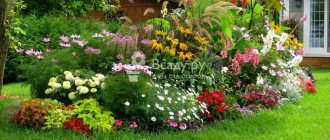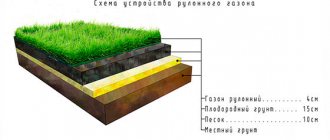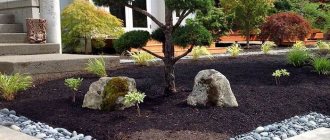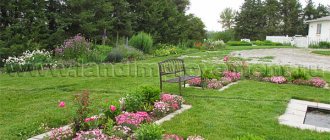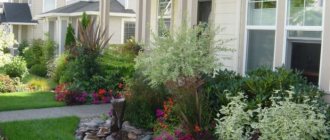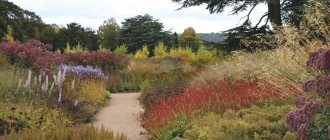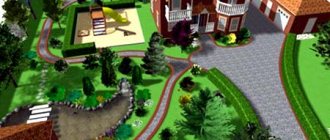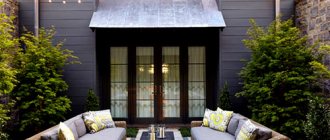One of the main elements in the formation of landscape design is the lawn. It can be used as an independent component or as a background that gives stylistic completeness to the area. A lawn in landscape design not only performs an aesthetic function, but also helps normalize the microclimate, absorbs dust, and reduces noise and vibration levels. As a complement to it, you can use various embankments, natural stones, flowers and other design options, allowing you to create an original design of the site.
The lawn is an integral part of almost any landscape design
Features of a lawn in landscape design
To create a beautiful lawn, you should carefully consider the selection of plants, which is carried out individually depending on the purpose of the lawn on the site, its location and other factors. There are many types of ornamental grasses, each of which has its own resistance to weathering and environmental conditions.
Nowadays, owners of even small suburban areas already have a small lawn with green grass or dream of creating one.
The greenery of the lawn pleases the eye and calms the nervous system
To arrange a lawn, you can use the services of professional specialists or perform all stages of its production yourself. To do this, you will need to properly prepare the soil and sow it with the selected seed composition.
The lawn creates its own microclimate, reducing moisture evaporation and lowering soil temperature
Lawn with flowers in flower beds
When it comes to decorating your garden with flowers, no one forces you to build huge flower arrangements and sculptures on the lawn. To make the yard beautiful, sometimes it will be enough to install modular flower beds, consisting of a frame equipped on the ground and compact containers for soil. In them you can place both flowers and various ornamental plants that attract attention.
When choosing plants for a flower bed, it is important to select them so that one species, when it fades, coincides with the beginning of the flowering of another flower.
Decorative flower pots can make your lawn more spectacular.
Flowers in such “pots” will certainly attract attention. A long flowerbed “edge”, located in the form of a strip along the edge of a path or hedge, will add a special bright contrast to the design of your site. Narrow “curbs” that border a lawn or a group of trees can be a good addition to the overall picture. The lawn in front of the house will look much more colorful if you include original garden figurines in its design. Many of which are additionally equipped with solar-powered diode lamps, so that in the evenings you will watch a stunning spectacle, without the cost of electricity.
The main types of lawns for a summer cottage and at home
There are several classifications according to which a lawn at a dacha can be classified as a certain type. Depending on the method of creating decorative elements, the lawn can be:
- natural - settles in areas with good grass stand;
- artificial, which is created on specially prepared or imported soil.
Depending on the number of types of plants used, lawns are divided into pure (1 type of grass) or mixed (several varieties).
Lawn geometry in Art Nouveau style
The main classification is the division of lawns near the house according to the purpose of decorative elements:
- for relax;
- decorative;
- blooming;
- sports;
- for extreme places;
- roll
Each type has its own characteristics and advantages, is used in different areas and performs certain functions.
Before purchasing herbs for sowing, you need to decide on the type of future lawn
For relax
It is a universal type that can be arranged in large and small areas. Excellent for cultural and sporting events.
This lawn can be used to cover a children's playground or a place to relax in the garden.
Decorative
Used for recreation and walking, it has a dense turf and has the most attractive appearance. Such a lawn grows evenly, does not allow weeds to pass through and can withstand moderate loads. It is divided into several types, among which are park, parterre, and meadow.
Decorative lawn suitable for landscaping walking areas
Parkovy
It does not require special care, since the herbs included in its composition are able to grow on various soils and tolerate unfavorable environmental conditions. It has a homogeneous structure and uniform color. Used as a decoration for recreation areas in courtyards, gardens and parks.
The classic park lawn is quite unpretentious, suitable for shady areas
Parterre
It is used for decorative filling of space, it looks expensive and elegant, but is quite sensitive to environmental conditions. To create it, selected herbal mixtures that are demanding on the soil are used. Such a lawn requires special care; it is not intended for walking and is used only for decorative purposes.
The ground lawn is created to enjoy its ideal view from the gazebo or from the windows of the house
Lugovoy
Similar to a park, it can withstand significant loads and is a lawn made of various types of grass.
Meadow lawn is well suited for relaxation and walking, has a natural appearance and does not need frequent mowing
Flowering
Used to imitate natural landscapes. When selecting plants, you should rely on their flowering period, which will make your landscape lawn bright for a long time. With the help of this type they decorate areas in which conditions for the growth of cultivated plants are not created.
The thought of a flowering meadow often comes when you get tired of mowing the classic lawn once or even twice a week.
For extreme places
Lawns for technical purposes are the most resistant to environmental conditions, as they consist of low grasses that can grow without sufficient lighting. Situated on inclined surfaces, they help preserve soil from erosion.
Special purpose lawns are used to cover areas that are difficult to maintain.
Sports
It has increased resistance to trampling and is used for arranging children's playgrounds and sports grounds. It consists of grasses with fast-growing wide shoots and also forming dense turf.
The composition of grasses for such a lawn depends on the purpose of the site - some grasses are more suitable for a football field, others for a children's playground
A properly formed lawn will look well-groomed for a long time. For play areas, it is best to plant mixtures with meadow bluegrass, red fescue and perennial ryegrass.
Roll
Allows you to get a complete landscape with a lawn in a short time. It is a seeded turf that is rolled out like a carpet. Such a lawn will not be overgrown with weeds and does not require treatment with a lawn mower or loosening the soil.
For a rolled lawn to take root, it needs high-quality watering.
Forum topics:
What about the lawn? (problems, illnesses). Growing a beautiful, healthy, and long-lasting lawn is no easy task. But even with careful lawn care, problems can happen. What problems there are and how to solve them - readers of the portal understand the topic.
Moorish lawn. A fragrant lawn strewn with a variety of flowers, just like in a field, is the dream of many summer residents. But a flower lawn is not as simple as it seems. It’s not enough to buy different flowers and plant them; you need to know what goes with what, where it likes to grow and what kind of care it requires. All the nuances of flower lawns are discussed in the topic.
Clover and lawn. A white clover lawn attracts many with its unusual appearance, decorativeness and seemingly low maintenance. But it also has not only positive, but also unpleasant sides. Therefore, before you get a clover lawn, you need to get acquainted with the experience of those who grow it. And for this, go to the topic!
Rolled lawn. A finished lawn is much more expensive and requires a lot of effort to install. But you can get a finished green lawn in a matter of days or even hours. Read about all the features of rolled lawns.
Photos of our lawns. Before buying and sowing any grass mixture, it would be good to see what a particular lawn will look like. This topic contains “live” examples of portal users’ lawns and their discussion.
Options for designing lawns at your summer cottage
Many people prefer to arrange their lawn themselves. To find out how to properly make a lawn at your dacha with your own hands, you should understand the features of the mixtures and accurately carry out all phases of the process, which consists of the following steps:
- Preparing the area. It is cleared of plants and debris by digging or using special preparations.
- Tillage in which the ground is plowed and leveled.
- Sowing of grass, which is carried out with fan-shaped movements, which ensures uniform distribution of the material along the entire perimeter.
After planting the seeds, the soil should be compacted, which will prevent them from being blown away and level the soil cover.
To understand whether a lawn will decorate a summer cottage and whether it will look aesthetically pleasing and attractive, you need to decide in advance on its type and purpose.
Compacting the soil with a roller
Sowing grass seeds
Watering the planted azon
A green lawn landscape can be decorated with all kinds of gravel paths, stone borders, sculptures or decorative elements. To create a pattern on the site, you can combine stripes with different heights of grass, which will allow you to get any pattern or geometric composition. To design the transition from the platforms, you can use alternating sections of grass and paving slabs. To create embankments, stone chips or mulch (bark, wood chips, nut husks) are used. Flowerbeds, which can be placed along paths, fences or in the center of the lawn, will perfectly complement the look.
Decorative lawn combined with flower beds
Beautiful lawn with parterre lawn
How to make a beautiful lawn
Growing a lawn consists of several stages:
- Soil preparation - removing weeds, if necessary - adjusting acidity and increasing fertility.
- Sowing grass, regular watering.
- First haircut. It is carried out after the grass reaches a certain size.
- Regular care and periodic haircuts.
In the process, you will have to monitor the soil moisture and remove weeds in a timely manner, fertilize from time to time, and replant bald spots that may appear after a too dry summer or too harsh winter. This, in brief, is the entire technology of growing a lawn, and then in detail, point by point.
Options for designing a lawn in front of the house
The space in front of the house requires special attention, since it is where the first impression of the site and housing is formed. That is why the question of how to make a lawn in front of the house is relevant for many homeowners. It is not recommended to divide your lawn into small areas as this can make it difficult to maintain. A single lawn will be an excellent backdrop for placing decorative elements on it.
A small ground lawn in front of the main entrance to the site
The lawn near the house can be supplemented with flower beds or small paths that are laid out from the gate to the entrance to the room. A few large objects will look better than many small ones, so you should not overdo it in using them. You can decorate the planting with vertical free-standing flower beds or vines framing the gazebos.
Children playing on a grass playground will bring less dirt home
Choosing the optimal season for sowing
The ideal time to plant lawn grass is from early spring to late autumn. Each period of the year except winter has advantages and disadvantages:
- In the spring, under conditions of warm soil, moderate air humidity, and loyal sun exposure, cereal seeds actively germinate. Together with them, weeds sprout, slowing down development and displacing herbaceous plants.
- At the beginning of summer, there is absolutely no chance of frosts that have a detrimental effect on young, immature lawn grass. Heat has a negative effect on sprouts. Direct rays of the sun provoke lethargy and drying of seedlings. The ideal time for planting is the heavy rainy season with an average daily temperature of 20-25 °C.
- In autumn, it is recommended to carry out sowing work at the beginning of September or before the arrival of winter. If the lawn base is planted immediately after the end of the summer heat, it will germinate well before frost with abundant artificial and natural watering. If the seeds are sown in slightly frozen soil before snow falls, they will sprout only in early spring. Over the winter they will take root and begin to withstand the effects of frost and wind. With the arrival of warm weather, the soil will warm up, provoking abundant growth of cereal grasses.
It is recommended to sow from early spring to late autumn
Recommendations for using lawn in landscape design
There are a number of tips that will help keep your lawn looking attractive and prevent it from overgrowing and drying out:
- Timely and correct haircut. It is not recommended to cut the grass very short. Haircut frequency: up to 2 times a week (more often in summer, less often in autumn). Before the procedure, it is recommended to comb the grass to avoid the growth of weeds.
- Aeration of the soil, due to which it is enriched with oxygen. For this, a rake or special fork is used.
- Timely and moderate watering. The procedure is carried out only in the evening using a spray. Puddles should not be allowed to appear, as they contribute to plant rotting.
- Feeding. Fertilizers are applied after each cutting, and their type depends on the type of seeds planted.
- Regular correction of the boundaries of the planting, which will give it the desired appearance.
The lawn on the site gives the impression of order, and well-groomed plants perfectly complement the landscape.
Lawn mowing
Lawn aeration
Combing the lawn
There are many photos of the design of lawns in front of the house, where you can see popular and exclusive options. The use of different grasses, thoughtful design and care will allow you to enjoy the beauty of the lawn for a long time, play on soft grass with children or host various events.
Sowing a lawn and laying a lawn step by step instructions
Nowadays, planting a beautiful green lawn on your own is no longer something unrealistic.
A large number of modern devices will simplify this process. You can make your own lawn using a lawn seed seeder or ready-made rolls.
Laying lawn rolls
- At the initial stage, we prepare the equipment necessary for laying the rolls - a rake, a wheelbarrow, a roller.
- We calculate the required number of rolls for the planting area. Typically a standard roll covers an area of 0.8 square meters. Rolls must be selected based on their composition and climatic conditions of the region.
- We clear the ground of debris and weeds. We dig up the soil and remove unnecessary roots.
- Level the surface to the same height.
- Then we install an automatic watering system.
- Let's move on to installation. It is better to lay out the rolls in a checkerboard pattern. The turf layer is smoothly distributed, pressing with planks. The rolls are laid close to each other. The maximum allowable gap should be no more than 1.5 centimeters. The seams formed are coated with a special solution.
- After installation, it is necessary to water the grass generously for several weeks.
Self-planting lawn
When organizing grass planting on your own, the owner of the site will significantly save his budget.
- First you need to prepare the selected soil for seedlings. The area is leveled and moistened.
- We buy lawn grass seeds, the quantity required for sowing. Usually this calculation is indicated on the packaging of the mixture. On average, 30÷50 grams of seed are used per 1 m².
- You can sow the grass manually, but it will be more careful to do this with special devices. To simplify this work, you can make small, uniform holes corresponding to the size of the seeds in a plastic bottle. And scatter the seeds using it.
- Next, you will need a rake to cover the soil.
- We compact the layer of earth with a roller.
- And for the first few weeks, we thoroughly water the seeded lawn. It is better to choose a cloudy time of year for planting mixtures.
How to choose lawn grass for a summer house and country house
If you study all the properties of the varieties of seeds offered on the horticultural market for planting lawns, you can identify several that are most adapted to Russian climatic conditions. The top three include those we have already mentioned more than once: red fescue, thin bentgrass, and meadow bluegrass. All of them belong to the group of low-growing lawn grass. They are not afraid of sudden temperature changes. As they grow, they create dense turf that prevents weeds from getting through. Another advantage of this trio is the ability to withstand frequent mowing.
Photo: Examples of lawn design in suburban areas
meadow lawn
A meadow lawn is created against the background of an existing grass stand by sowing a mixture of cereals selected taking into account the growing conditions.
How can I add new herbs? Usually, for this purpose, the turf is subjected to surface treatment and the grass mixture is sown. The famous English gardener Monty Don uses an ordinary shovel for this and lightly digs up the top layer of soil with a third of the bayonet. Then he levels it with a rake and sows new grasses. Minor damage to already growing grasses stimulates the formation of new growth.
The most commonly used crops are:
- horned frog;
- sainfoin;
- clover (red, white, hybrid);
- alfalfa (yellow, blue, hop-like).
The mixture for meadow lawn blooms picturesquely, forming bright lawns and clearings.
IN THE PHOTO: Meadow lawn on both sides of the grass path.
Rules for choosing a landing site
When dividing the landscape of the site into certain zones, keep in mind that not all lawn mixtures will grow equally well where you have allocated a place for them.
- So, an English lawn needs complete openness, absence of shade and wind.
- Any grass will not grow normally in an area of constant shade, which occurs in the immediate vicinity of buildings.
- If you are planning to sow a lawn under an orchard or ornamental trees, then within the radius of the crown the lawn has little chance of survival. Firstly, most of the nutrition will be taken by the root system of more powerful trees. Secondly, the branches will provide a large amount of shadow, interfering with photosynthesis processes. As a result, the grass will have a pale appearance. You will either have to sacrifice the lower branches of the trees and cut them off, or refuse to sow grass in this place.
- If the dacha plot is located in a low-lying, waterlogged area, then the grass roots will constantly rot. The lawn does not like waterlogging, so you will have to provide high-quality drainage. True, there are mixtures of herbs that grow even when water is stagnant, but even they do not need a constant excess of moisture.
- If there are elevation changes in the area, then in places of transition the soil is susceptible to erosion and washout. You need to smooth out the slopes so that their steepness does not exceed 30˚ and additionally reinforce them with a mesh that will hold the soil and prevent it from crumbling.
- You should not make a lawn path in a place where there is constant movement of people and cars, for example, from the gate to the house. By trampling down the same rut every day, you will compact the soil so much that the grass will be deprived of oxygen access to the roots and will “suffocate.” Even sports mixtures will not work in this case, because they are designed for heavy traffic of people throughout the entire site, and not in one narrow strip. If you want to keep the area green so much, then lay strips of tiles or wooden blocks between the lawn so that you can walk on them rather than on the grass.
Sports turf
Grass mixtures for sports turf include not just wild plant species that are resistant to trampling, but specially bred varieties of the following grasses:
- Perennial ryegrass or perennial ryegrass (varieties 'Platinum', 'Stravinsky', 'Neruda' and others);
- Bentgrass 'Cobra Nova', 'Cromie';
- Meadow bluegrass varieties 'Panduro', 'Miracle', 'Julius';
- Modified red fescue varieties 'Trophy', 'Blenheim', 'Maritsa' and others.
IN THE PHOTO: Grasses for sports lawns must be very resistant to trampling.


